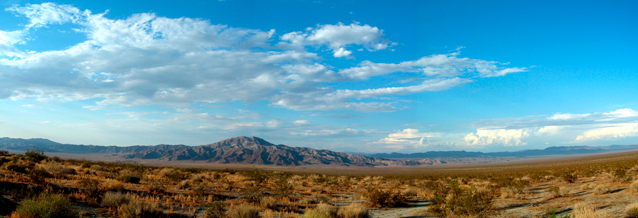Water conservation is always important in the desert, but saving water is even more critical during the current period of historic drought in the state of California. We can learn about how to be water-wise by looking to the example of desert native species, which have evolved to cope with rains that are not only scarce but unpredictable. Native plants know how to hunker down and conserve water during tough times—and that’s a valuable lesson for all of us who live in or visit the desert.

NPS/Robb Hannawacker
When gazing out over vast expanses of desert terrain, the untrained eye may skip over what appear to be dead shrubs. But a landscape that often gets dismissed as drab and barren is in fact full of thriving life. Desert native plants are no strangers to scant precipitation, and have adapted to the harsh uncertainty of water availability by developing a cyclical defense mechanism: plants spend much of the year dormant, growing and flowering mainly when water is available.
The desert looks most glorious in the spring season, and is at its best in years when late winter and early spring bring abundant rain. The extensive root systems of “dead-looking” plants respond to limited seasonal water as if it were a gift, absorbing as much as possible and then producing showy greenery and floral palettes in gratitude. The plants take advantage of the wet season as an opportunity to grow and reproduce.
When extreme summer heat arrives, the same plants withdraw their outward displays of spring’s promise and splendor, pulling back into life-support mode. Though they may seem unsightly, these plants are not only alive, but continuing to contribute to the wellbeing of other desert species. Many desert plants go to seed in the summer, providing much-appreciated sustenance for birds and small animals. With the monsoon rains of late summer, fallen seeds sprout and establish roots in preparation for the cold winter ahead.
From a desert plant’s perspective, both summer and winter can be hostile seasons that require a serious investment in water efficiency. Plants focus their energy on growing deep or spreading roots. A well-developed root system then allows them to soak up the occasional rain. Plants also cut back on moisture loss with adaptations like small, waxy, or drought-deciduous leaves. Plants may hope for rain, but they prepare for drought.
Humans in the desert need to do the same. Residents of Joshua Tree National Park’s gateway communities are all working to save water. “Save water: live like a desert native” is more than a motto. It’s a mindset to use water wisely. Be conscious of every precious drop. After all, water is life to all of us.
Tips for Saving Water
The National Park Service encourages you to do your part to conserve water while you visit Joshua Tree and the surrounding area. Here are a few simple things you can do to make a difference:
- When dining out, only order water if you plan to drink it.
- Reuse linens and towels during your stay as a guest.
- Take short showers (3-5 minutes) instead of lingering under the spray or taking a bath.
- Swamp coolers use lots of water. Please turn them off when you’re not in the room.
- While visiting, if you see what you think is a water leak or a wet area where none should be, contact the local Water District.
Thank you for helping us protect our precious water resources.
Last updated: March 22, 2016
